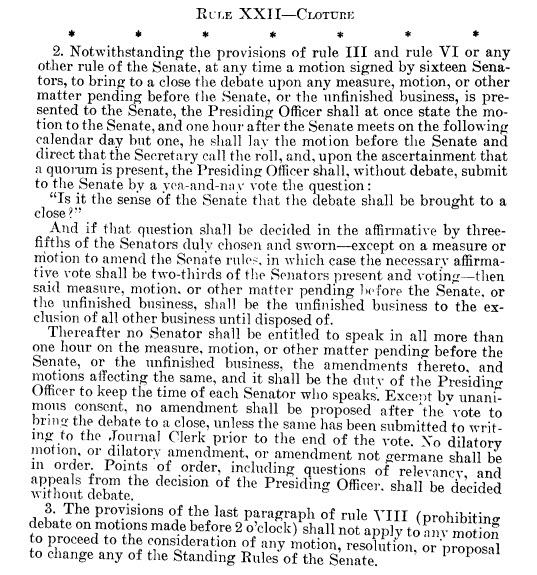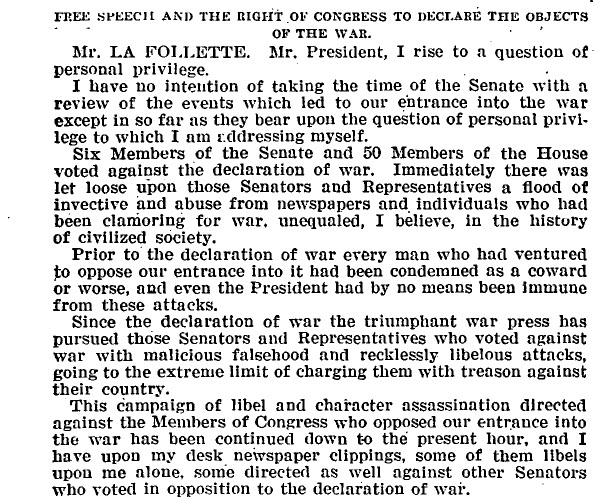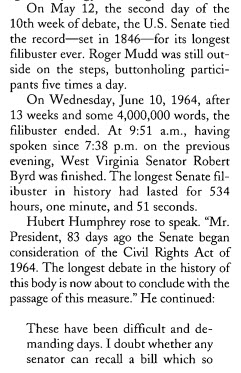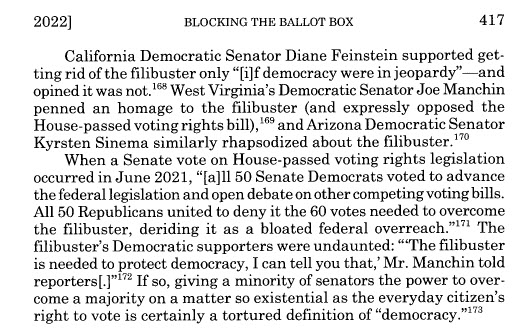It’s a word we hear in the news all the time: the filibuster. Whether it’s politicians calling for an end to the filibuster, worrying about an impending filibuster, or praising the merits of the filibuster, the filibuster is both a loved and feared word depending on who you ask. It has the power to make or break any bill that passes through the Senate doors. So what is a filibuster, where did it come from, and why do we still use it today? Let’s dive into the resources in HeinOnline to learn more about the funny word that has a chokehold on the American government.
Origins of the Filibuster
The term “filibuster” comes from a Dutch word for “pirate.”[1]The Filibuster, 8 LAW Soc’y J. 344 (1938). This article can be found in HeinOnline’s Law Journal Library. The concept was derived initially in 1806, when Vice President Aaron Burr encouraged the Senate to eliminate a process called the “previous question motion,”[2]Gregory Koger & Sergio J. Campos, The Conventional Option, 91 Wash. U. L. REV. 867 (2014). This article can be found in HeinOnline’s Law Journal Library. which allowed for a simple majority to force a vote. Although arguably not Burr’s intention, removing this process essentially created a loophole to allow senators to delay a vote indefinitely by prolonging debate.
One of the first successful filibusters came in 1841, when the Democratic minority in the senate filibustered a bill to establish a national bank[3]Robert J. Dole. Historical Almanac of the United States Senate: A Series of Bicentennial Minutes Presented to the Senate during the One Hundredth Congress (1989). This document can be found in HeinOnline’s U.S. Congressional … Continue reading for 14 days. The practice became even more popular in the 1850s in efforts by the minority party in the Senate to prevent bills they opposed from passing.

As a note, there is no filibuster for the House of Representatives. As a much larger legislative body, there are rules in place for how long a representative can speak on the House floor.
The Cloture
In 1917, President Woodrow Wilson was preparing to pass a bill that would arm U.S. merchant ships against German U-Boats. However, the bill was filibustered—as were several other bills in relation to the war over the preceding years. With pressure for America to get involved in the war steadily growing, Wilson got fed up, claiming, “the senate of the United States is the only legislative body in the world which cannot act when its majority is ready for action. A little group of willful men, representing no opinion but their own, have rendered the great government of the United States helpless and contemptible.”[4]Lindsay Rogers, American Government and Politics, 13 AM. POL. Sci. REV. 251 (1919). This article can be found in HeinOnline’s Law Journal Library. This led to a special congressional session on March 8, 1917,[5]55 Cong. Rec. 19 (1917). This document can be found in HeinOnline’s U.S. Congressional Documents database. where the Senate adopted Rule 22 establishing “cloture,” allowing for a two-thirds majority vote to end a filibuster.
Cloture was first tested in 1919, when the Senate used it to end the filibuster against the Treaty of Versailles[6]“Amending Rule XXII to provide for cloture by affirmative vote of three-fifths of Senators present and voting.” U.S. Congressional Serial Set, , 1961, pp. 1-8. HeinOnline, … Continue reading ending World War I. However, establishing cloture with a two-thirds majority wasn’t easy—in fact, in the ensuing five decades, it was only successful five times. For that reason, in 1975, the Senate agreed to reduce the number of votes required for cloture, dropping it to three-fifths,[7]Library of Congress, and United States. Senate Cloture Rule (1977). This document can be found in HeinOnline’s U.S. Congressional Documents database. or 60 senators during a full session. Additionally, prior to the 1970s, a filibuster had the power to hold up not only the bill in question, but all additional Senate matters, as only one bill was allowed on the floor at once. This was adjusted to a two-track system,[8]“Summary of major achievements, 94th Cong., 2d session.” U.S. Congressional Serial Set, , 1976, pp. I-342. HeinOnline, https://heinonline.org/HOL/P?h=hein.usccsset/usconset21322&i=32. This document can be found in … Continue reading allowing multiple bills to be pending on the Senate floor so that a filibuster couldn’t bring a halt to all Senate proceedings.

Famous Filibusters Through the Years
1917
One of the most devout filibusterers in U.S. history was Wisconsin senator Robert La Follette. Throughout his tenure, he invoked several filibusters, particularly regarding involving America in World War I. He was the one who invoked the filibuster opposing Wilson’s bill to arm merchant ships, and several other senators agreed with him and supported his filibuster. La Follette also later voted against declaring war and continued to protest involvement in the war. His state legislature accused him of treason, while senators discussed expelling him from Congress. In response, on October 6, 1918, he delivered a famous three-hour speech defending the right to free speech in times of war.[9]55 Cong. Rec. 7873 (1917). This document can be found in HeinOnline’s U.S. Congressional Documents database. Although he was condemned during his time, the Senate did later name La Follette as one of its five most outstanding former members.[10]“Proceedings at unveiling of portraits of 5 outstanding Senators.” U.S. Congressional Serial Set, , 1959, p. i-40. HeinOnline, https://heinonline.org/HOL/P?h=hein.usccsset/usconset22274&i=180. This document can be … Continue reading

1930
Louisiana senator Huey Pierce Long[11]Richard A. Baker. 200 Notable Days: Senate Stories, 1787 to 2002 (2006). This document can be found in HeinOnline’s U.S. Congressional Documents database. was eventually assassinated, but before that, he launched a speech for 15-and-a-half hours in order to filibuster President Franklin Roosevelt’s selections to fill National Recovery Administration senior positions. During his speech, Long read and commented on each section of the U.S. Constitution.
1957
In one of the most famous and longest filibusters, South Carolina senator Strom Thurmond spoke for more than 24 hours in opposition of the Civil Rights Act of 1957.[12]Howard H. Quint. Profile in Black and White: A Frank Portrait of South Carolina (1958). This document can be found in HeinOnline’s Civil Rights and Social Justice database. To fill the time, he read the entirety of the Declaration of Independence, the U.S. Criminal Code, and the voting laws of 48 states.
1964
A group of Southern senators filibustered the Civil Rights Act of 1964.[13]John Greenya, Rites of Passage, 14 Wash. LAW. 35 (2000). This article can be found in HeinOnline’s Bar Journals Library. It wasn’t until 13 weeks later that the Senate was able to achieve the two-thirds vote needed for cloture to vote on the act. In fact, a major argument against the filibuster is its historical use in blocking important civil rights legislation.

And although fictional, the filibuster was made famous in the 1939 film Mr. Smith Goes to Washington,[14]Tom Harkin, Fixing the Filibuster: Restoring Real Democracy in the Senate, 95 IOWA L. REV. BULL. 67 (2009-2010). This article can be found in HeinOnline’s Law Journal Library. in which James Stewart plays a young senator who talks for almost 24 hours to delay a vote on a corrupt bill. However, since the 1970s, most filibusters have been “silent,” which means that most bills won’t be brought to the Senate floor if there is even a threat of a filibuster—long speeches are no longer necessary, although a suggested filibuster reform is to bring them back to discourage such frequent use.
The Filibuster Today
Today, filibusters can only be used for legislation—in the 2010s, efforts to filibuster cabinet and federal judge nominations from President Barack Obama led to a reform that allows for a simple majority vote on executive and judicial nominations.[15]Charles Tiefer & Kathleen Clark, Deliberation’s Demise: The Rise of One-Party Rule in the Senate, 24 ROGER Williams U. L. REV. 46 (2019). This article can be found in HeinOnline’s Law Journal … Continue reading In addition, only a simple majority is needed to adopt certain bills that address budgetary issues. But regardless, the use of filibusters has increased drastically. During the 1950s, there was an average of one filibuster per Congress. The 111th Congress had 137 filibusters in just two years. And the threat of a filibuster has halted legislation on several fronts, including election reform and gun legislation, because today, new bills usually don’t even go to vote unless there are a guaranteed 60 votes to break a potential filibuster.
Therefore, there is currently debate, especially among Democrats, to either reform the filibuster, such as by reducing cloture to a majority vote, or to eliminate it altogether. However, to reform the filibuster, there would need to be a guaranteed 60 votes to break the inevitable filibuster that would come from such legislation. In a vote last year to bring filibuster reform to help pass a voting rights bill,[16]Brendan Williams, Blocking the Ballot Box: The Republican War on Voting Rights, 28 WM. & MARY J. RACE GENDER & Soc. Just. 389 (2022). This article can be found in HeinOnline’s Law Journal Library. two Democratic senators, Joe Manchin and Kyrsten Sinema, as well as all Republicans voted against it.

Want to learn more about filibusters? There’s tons of content in HeinOnline to assist you in your research. And be sure to subscribe to the HeinOnline Blog for timely, relevant posts like this one delivered right to your inbox!
HeinOnline Sources[+]
| ↑1 | The Filibuster, 8 LAW Soc’y J. 344 (1938). This article can be found in HeinOnline’s Law Journal Library. |
|---|---|
| ↑2 | Gregory Koger & Sergio J. Campos, The Conventional Option, 91 Wash. U. L. REV. 867 (2014). This article can be found in HeinOnline’s Law Journal Library. |
| ↑3 | Robert J. Dole. Historical Almanac of the United States Senate: A Series of Bicentennial Minutes Presented to the Senate during the One Hundredth Congress (1989). This document can be found in HeinOnline’s U.S. Congressional Documents database. |
| ↑4 | Lindsay Rogers, American Government and Politics, 13 AM. POL. Sci. REV. 251 (1919). This article can be found in HeinOnline’s Law Journal Library. |
| ↑5 | 55 Cong. Rec. 19 (1917). This document can be found in HeinOnline’s U.S. Congressional Documents database. |
| ↑6 | “Amending Rule XXII to provide for cloture by affirmative vote of three-fifths of Senators present and voting.” U.S. Congressional Serial Set, , 1961, pp. 1-8. HeinOnline, https://heinonline.org/HOL/P?h=hein.usccsset/usconset22333&i=183. This document can be found in HeinOnline’s U.S. Congressional Serial Set database. |
| ↑7 | Library of Congress, and United States. Senate Cloture Rule (1977). This document can be found in HeinOnline’s U.S. Congressional Documents database. |
| ↑8 | “Summary of major achievements, 94th Cong., 2d session.” U.S. Congressional Serial Set, , 1976, pp. I-342. HeinOnline, https://heinonline.org/HOL/P?h=hein.usccsset/usconset21322&i=32. This document can be found in HeinOnline’s U.S. Congressional Serial Set database. |
| ↑9 | 55 Cong. Rec. 7873 (1917). This document can be found in HeinOnline’s U.S. Congressional Documents database. |
| ↑10 | “Proceedings at unveiling of portraits of 5 outstanding Senators.” U.S. Congressional Serial Set, , 1959, p. i-40. HeinOnline, https://heinonline.org/HOL/P?h=hein.usccsset/usconset22274&i=180. This document can be found in HeinOnline’s U.S. Congressional Serial Set database. |
| ↑11 | Richard A. Baker. 200 Notable Days: Senate Stories, 1787 to 2002 (2006). This document can be found in HeinOnline’s U.S. Congressional Documents database. |
| ↑12 | Howard H. Quint. Profile in Black and White: A Frank Portrait of South Carolina (1958). This document can be found in HeinOnline’s Civil Rights and Social Justice database. |
| ↑13 | John Greenya, Rites of Passage, 14 Wash. LAW. 35 (2000). This article can be found in HeinOnline’s Bar Journals Library. |
| ↑14 | Tom Harkin, Fixing the Filibuster: Restoring Real Democracy in the Senate, 95 IOWA L. REV. BULL. 67 (2009-2010). This article can be found in HeinOnline’s Law Journal Library. |
| ↑15 | Charles Tiefer & Kathleen Clark, Deliberation’s Demise: The Rise of One-Party Rule in the Senate, 24 ROGER Williams U. L. REV. 46 (2019). This article can be found in HeinOnline’s Law Journal Library. |
| ↑16 | Brendan Williams, Blocking the Ballot Box: The Republican War on Voting Rights, 28 WM. & MARY J. RACE GENDER & Soc. Just. 389 (2022). This article can be found in HeinOnline’s Law Journal Library. |



